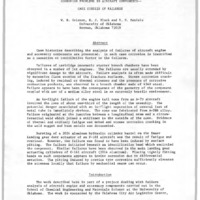-
Title
-
Corrosion Problems In Aircraft Components -- Case Studies Of Failures
-
Report Number
-
AFWAL-TR-81-4019 Volume II p. 241-270
-
Creator
-
Coleman, W. R.
-
Block, R. J.
-
Daniels, R. D.
-
Corporate Author
-
University of Oklahoma
-
Laboratory
-
Materials Laboratory
-
Date
-
1980
-
Date Issued
-
1980-11
-
Extent
-
30
-
Identifier
-
ADA115875
-
Abstract
-
Case histories describing the analysis of failures of aircraft engine and accessory components are presented. In each case corrosion is identified as a causative or contributive factor to the failures. Failures of cartridge pneumatic starter breech chambers have been observed in a number of jet engines. The failures are usually attended by significant damage to the aircraft. Failure analysis is often made difficult by excessive flame erosion of the fracture surfaces. Stress corrosion cracking, induced by residual or thermal stresses and the presence of corrosive combustion products, was observed in a breech chamber made of 4340 steel. Failure appears to have been the consequence of the geometry of the component coupled with use of a medium alloy steel in an extremely hostile environment. An in-flight failure of the engine tail cone from an A-7D aircraft involved the loss of about one-third of the length of the assembly. The potential danger associated with an in-flight separation of several feet of metal tube is immediately obvious. The cone was fabricated from A-286 alloy. Failure originated at the junction between a longitudinal seam and a circum-
ferential weld which joined a stiffener to the outside of the cone. Evidence of thermal and ordinary fatigue was noted and stress corrosion cracking in the weld nugget and base metals was documented. Bursting of a 2024 aluminum hydraulic cylinder barrel on the inner landing gear door actuator of an F-101 aircraft was the result of fatigue and overload. However, the failure was found to have been induced by surface pitting. The failure initiated beneath an identification band which encircled the component. Similar failures have been observed in the main landing gear actuating cylinders of C-141 aircraft (2014 aluminum). Placing tightly fitting bands on such components appears to invite corrosion due to differential aeration. The pitting induced by crevice type corrosion sufficiently elevates the stresses locally that failure by mechanical means can occur.
-
Description
-
Case histories describing the analysis of failures of aircraft engine and accessory components are presented. In each case corrosion is identified as a causative or contributive factor to the failures. Failures of cartridge pneumatic starter breech chambers have been observed in a number of jet engines. The failures are usually attended by significant damage to the aircraft. Failure analysis is often made difficult by excessive flame erosion of the fracture surfaces. Stress corrosion cracking, induced by residual or thermal stresses and the presence of corrosive combustion products, was observed in a breech chamber made of 4340 steel. Failure appears to have been the consequence of the geometry of the component coupled with use of a medium alloy steel in an extremely hostile environment. An in-flight failure of the engine tail cone from an A-7D aircraft involved the loss of about one-third of the length of the assembly. The potential danger associated with an in-flight separation of several feet of metal tube is immediately obvious. The cone was fabricated from A-286 alloy. Failure originated at the junction between a longitudinal seam and a circum-
ferential weld which joined a stiffener to the outside of the cone. Evidence of thermal and ordinary fatigue was noted and stress corrosion cracking in the weld nugget and base metals was documented. Bursting of a 2024 aluminum hydraulic cylinder barrel on the inner landing gear door actuator of an F-101 aircraft was the result of fatigue and overload. However, the failure was found to have been induced by surface pitting. The failure initiated beneath an identification band which encircled the component. Similar failures have been observed in the main landing gear actuating cylinders of C-141 aircraft (2014 aluminum). Placing tightly fitting bands on such components appears to invite corrosion due to differential aeration. The pitting induced by crevice type corrosion sufficiently elevates the stresses locally that failure by mechanical means can occur.
-
Distribution Classification
-
1
-
Distribution Conflict
-
No
-
DTIC Record Exists
-
No
-
Illinois Tech Related
-
No
-
Photo Quality
-
Complete
-
Report Availability
-
Full text available
-
Type
-
article
 article11
article11